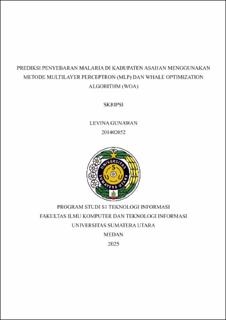Prediksi Penyebaran Malaria di Kabupaten Asahan Menggunakan Metode Multilayer Perceptron (MLP) dan Whale Optimization Algorithm (WOA)
Prediction of Malaria Abundance in Asahan Regency Using Multilayer Perceptron (MLP) and Whale Optimization Algorithm (WOA) Method

Date
2025Author
Gunawan, Levina
Advisor(s)
Rahmat, Romi Fadillah
Lubis, Fahrurrozi
Metadata
Show full item recordAbstract
Malaria is a disease that can be transmitted through mosquito bites. Today, malaria has become an infectious disease with a high mortality rate. According to data from the World Health Organization, an estimated 249 million cases of malaria have been recorded globally by 2022. In Indonesia alone, malaria cases will reach a total of 1.2 million cases by 2022. Asahan Regency is one of the districts that is classified as moderately endemic in North Sumatra. In addition, climatic factors including temperature, rainfall, humidity, and others also significantly affect the spread of malaria. In connection with the government's national goal to eradicate malaria by 2030, a more accurate prediction model is needed to predict the number of malaria abundance so treatment can be performed effectively. This research proposes the MLP-WOA model which is a hybrid of Multilayer Perceptron (MLP) and Whale Optimization Algorithm (WOA) method to predict the number of malaria abundance in Asahan Regency, North Sumatra on a weekly basis. This research will also synthesize the dataset for 2015-2018 using TimeGAN. The most optimal model produced test MAE, MSE, RMSE, and R2 of 5.320, 40.910, 6.396, and 0.808, respectively. The model parameters used were a data split of 7:3, 2000 iterations, 20 search agents, 2 hidden layers, and 5 and 4 neurons in each hidden layer. TimeGAN helped to add historical data and improved the model performance significantly. Rainfall, floods and puddles, and population density showed a significant influence on positive malaria cases in Asahan Regency.
Collections
- Undergraduate Theses [873]
